2025年9月4日,生命科学中心Woo Jae Kim课题组在《公共科学图书馆-生物学》(PLOS Biology)背靠背发表两项研究成果,揭示了一组特定神经元及其神经肽信号如何统筹果蝇的复杂、情境依赖性行为。这两篇论文为理解动物如何通过内部状态来调节决策和能量平衡提供了新的视角。
第一项研究题为《SIFa神经肽能神经元统筹果蝇雄性交配行为与能量平衡》(SIFa peptidergic neurons orchestrate the internal states and energy balance of male Drosophila melanogaster),研究团队聚焦于果蝇大脑和腹神经索中仅有的四个SIFamide (SIFa) 神经元。结果显示,这些神经元能够作为枢纽,整合饥饿、社交环境等内部信号,并将其转化为具体的行为输出。激活SIFa神经元会缩短交配时长并增加取食,而抑制其活性则会降低取食行为。这表明SIFa神经元在调控交配节律、能量平衡及繁殖策略中发挥关键作用。
第二项研究题为《神经肽介导的突触可塑性调控果蝇情境依赖性交配行为》(Neuropeptide-mediated synaptic plasticity regulates context-dependent mating behaviors in Drosophila),团队进一步解析了SIFa如何通过其受体SIFaR调控两种相反的交配行为:在竞争者存在时延长交配(LMD),在经历过交配后缩短交配(SMD)。研究发现,SIFa-SIFaR通路会根据社交情境发生突触重塑,并通过与另一种神经肽——心肽(Corazonin, Crz)及其受体的中继作用,共同决定交配时间的长短。值得注意的是,Crz受体在胶质细胞中的表达对LMD行为的正常调控至关重要,提示神经元与胶质细胞共同参与了行为调节。
两项研究共同确立了SIFa信号作为核心神经肽枢纽的地位,表明其能够灵活整合内部状态、递质系统和神经肽中继,从而调控行为。这一发现不仅阐明了果蝇如何将生理状态转化为适应性决策,也为更广泛的神经科学研究提供了基础。
Woo Jae Kim研究员为两篇论文的通讯作者。第一篇论文中,Woo Jae Kim课题组博士研究生宋雨桐、张天目为共同第一作者。第二篇论文中,Woo Jae Kim课题组博士研究生张天目为第一作者。
本研究获得了哈工大生命科学中心启动基金等资助。
文章链接:https://doi.org/10.1371/journal.pbio.3003345(第一项研究)
https://doi.org/10.1371/journal.pbio.3003330(第二项研究)
Title: Dr. Woo Jae Kim’s team reveals how neuropeptide circuits shaping energy balance and mating strategies in Drosophila melanogaster
September 4th, 2025 — Back-to-back studies from Woo Jae Kim’s group at the HIT Center for Life Sciences have uncovered how a single set of neurons and their neuropeptide signaling orchestrate complex, context-dependent behaviors in male fruit flies. The two papers were published simultaneously in PLOS Biology, providing new insights into how internal states shape decision-making and energy balance.
In the first study, titled “SIFa peptidergic neurons orchestrate the internal states and energy balance of male Drosophila melanogaster”, the researchers examined four SIFamide (SIFa) neurons with highly elaborate branching across the fly brain and ventral nerve cord. They showed that SIFa neurons act as hubs integrating internal cues such as hunger and social context, then translating them into behavioral outputs. By selectively activating or silencing SIFa neurons, the team demonstrated that these cells regulate mating duration, food intake, and sleep. Strikingly, activation shortened mating while boosting feeding, whereas silencing suppressed feeding. The findings highlight SIFa neurons as critical modulators of interval timing, energy balance, and reproductive strategy.
The companion article, “Neuropeptide-mediated synaptic plasticity regulates context-dependent mating behaviors in Drosophila”, focused on how SIFa communicates through its receptor, SIFaR, to generate two opposite mating behaviors: longer mating duration (LMD) in the presence of rivals and shorter mating duration (SMD) after sexual experience. The study revealed that SIFa-SIFaR interactions undergo synaptic reorganization depending on social context, and that the relay of neuropeptides—including corazonin (Crz) and its receptor—plays a decisive role in timing behavior. Importantly, Crz receptor expression in glial cells was shown to be essential for proper regulation of LMD, underscoring how both neurons and glia cooperate in behavior control.
Together, these studies establish SIFa signaling as a central neuropeptidergic hub that flexibly integrates internal states, neurotransmitter systems, and neuropeptide relays to modulate behavior. The discoveries shed light on fundamental principles of how animals translate physiological states into adaptive decisions—a theme with broad implications for neuroscience beyond insects.
Dr. Woo Jae Kim is the corresponding author of both papers. In the first paper, PhD students Yutong Song and Tianmu Zhang from Dr. Woo Jae Kim’s lab are co–first authors. In the second paper, PhD student Tianmu Zhang is the first author.
Both studies were supported by the Start-up Fund of the HIT Center for Life Sciences, among other funding sources.
Paper link: https://doi.org/10.1371/journal.pbio.3003345 (first paper)
https://doi.org/10.1371/journal.pbio.3003330 (second paper)
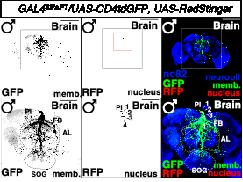
图例:在 PI 区域表达的四个 SIFamide神经肽神经元,可能是果蝇中分支最广泛的肽能神经元。
Legend: The neuropeptide SIFamide expressed in four neurons in PI region likely the most extensively branching peptidergic neurons in Drosophila.
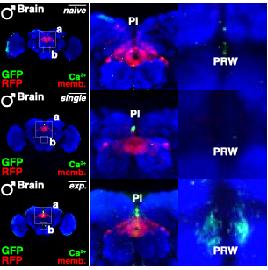
图例:SIFa 神经元的神经活动决定了时间间隔行为的内在状态。
Legend: The neuronal activity of SIFa neurons determine internal states for interval timing behavior.
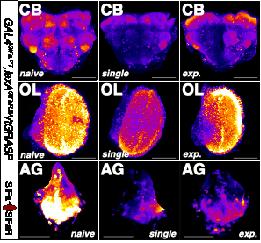
图例:SIFa与SIFaR之间的突触连接会随不同的社会及交配情境而变化。
Legend: Synaptic connections between SIFa and SIFaR vary in different social-sexual context.
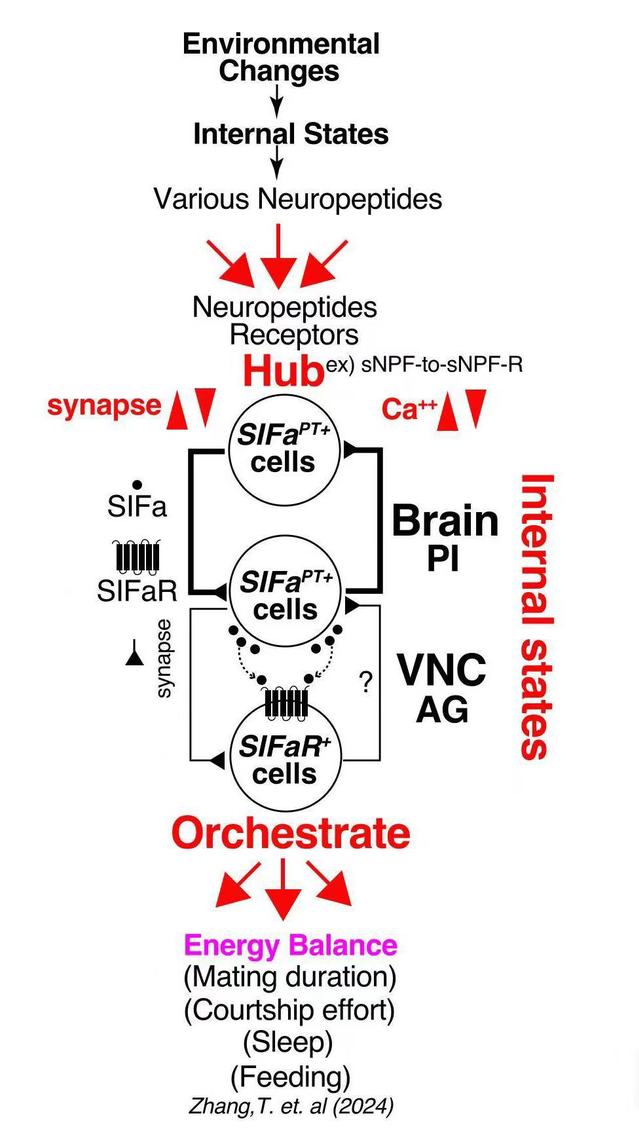
图例:示意图展示了果蝇大脑 PI 区 SIFa 神经元与腹神经索 AG 区 SIFaR 神经元的结构与功能连接,以及受体激活如何调节能量的节约与消耗。
Legend: The schematic shows the structural and functional connections between SIFa neurons in the PI region of the Drosophila brain and SIFaR neurons in the AG of the ventral nerve cord, illustrating how receptor activation regulates energy conservation and expenditure.
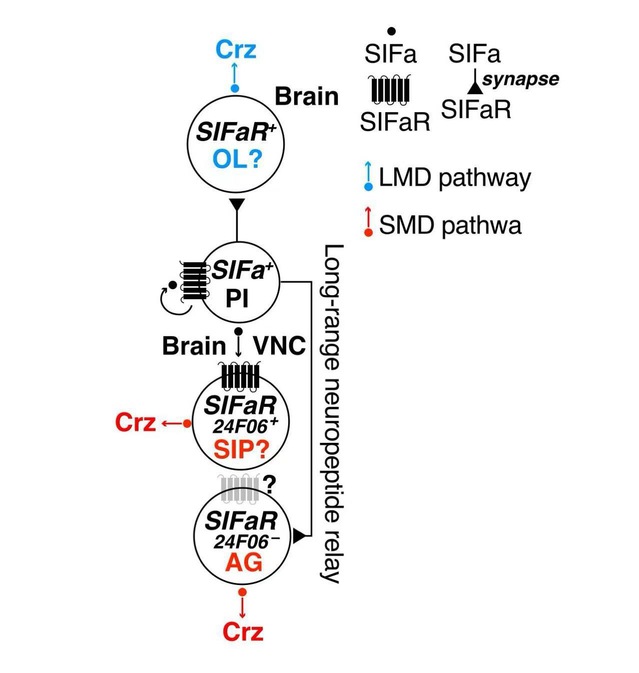
图例:示意图展示了 Crz 通过 SIFa-SIFaR 信号通路调控 LMD 和 SMD 的机制。
Legend: Illustration depicting the mechanism by which Crz modulates LMD and SMD via SIFa-SIFaR signaling pathway.
文稿:宋雨桐、张天目
初审:王广福、马文君
复审:张 勇
终审:于 光


